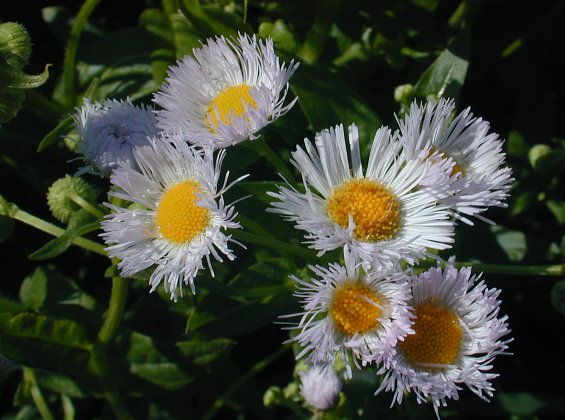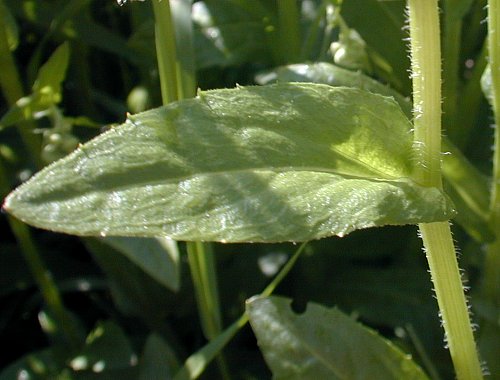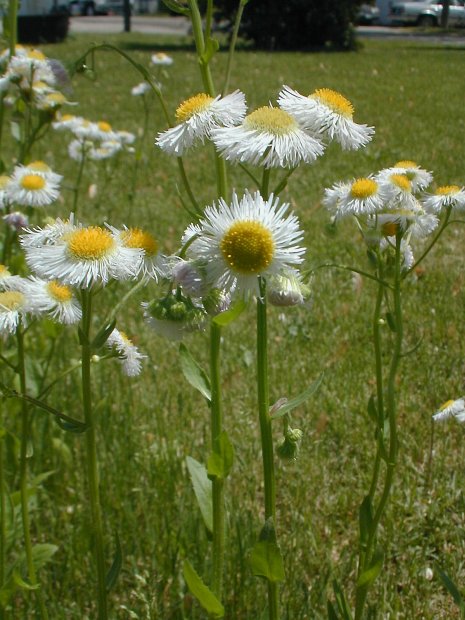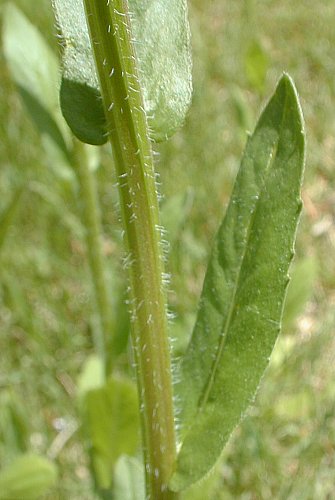Description: This herbaceous plant is a biennial or short-lived perennial. It is ¾–2½' tall and usually unbranched, except toward the inflorescence. Initially, there is a low rosette of basal leaves that disappears when the plant bolts during the spring. The central stem and upper stems are light green, multiangular-terete, and sparsely to moderately covered with spreading white hairs. Alternate leaves occur along the entire length of these stems, becoming smaller in size and more sparse as they ascend. These leaves are up to 3¾" long and 1¼" across; they are ovate, lanceolate, oblanceolate, or narrowly elliptic in shape. The leaf margins are often short-ciliate; upper leaves usually have entire (toothless) margins, while lower leaves are usually sparingly toothed, especially toward their tips. All of these leaves clasp the stems at their bases to a greater or less extent. Both the upper and lower leaf surfaces are light to medium green and sparsely short-pubescent to nearly glabrous. The central stem terminates in a panicle of flowerheads that is somewhat flat-headed. In addition, smaller panicles or clusters of flowerheads may develop from the axils of upper leaves. The branches and peduncles of these flowerheads are similar to the stems, except their hairs are shorter. There are often solitary leafy bracts up to 1" long where the branches of an inflorescence divide; these bracts are narrowly lanceolate.

Each daisy-like flowerhead is ½–¾" across, consisting of 100-300 ray florets that surround a dense head of disk florets. The petaloid rays of the flowerhead are white (less often light pink or light violet), linear in shape, and densely distributed. The corollas of the disk florets are 2-3 mm. long, yellow, and narrowly tubular in shape. Surrounding the cup-like base of each flowerhead, there are numerous appressed phyllaries in a single overlapping series. Individual phyllaries are light green, linear in shape, and sparsely short-pubescent. The blooming period occurs from late spring to mid-summer, lasting about 1–1½ months. There is either a mild floral fragrance or none. Afterwards, this plant tends to die down for the remainder of the summer. The florets are replaced by achenes with small tufts of white bristly hair; they are distributed by the wind. The narrow achenes are 0.5–1 mm. long. The root system is shallow and fibrous, sometimes forming a small caudex on older plants. Colonies of plants occasionally occur at favorable sites.

Cultivation:
The preference is full to partial sun, moist conditions, and
soil containing fertile loam, although soil containing some clay or
gravel is readily tolerated. This plant will adapt to drier locations,
but its size will be reduced. Like similar fleabanes (Erigeron spp.)
that are somewhat weedy, it may spread to undesirable locations by
reseeding itself.
Range & Habitat:
Philadelphia Fleabane is a common plant that occurs in almost every
county of Illinois (see Distribution
Map), where it is native. Habitats include moist depressions
in black soil prairies, moist meadows along rivers, low areas along
ponds and small lakes, edges of marshes, roadside
ditches, moist depressions along railroads, fallow fields,
vacant lots, and waste areas. Moist disturbed areas
are preferred.

Faunal Associations: The nectar and pollen of the flowerheads attract a variety of insects, including little carpenter bees (Ceratina spp.), cuckoo bees (Nomada spp.), mason bees (Osmia spp.), leaf-cutting cuckoo bees (Stelis spp.), Halictid bees, Halictid cuckoo bees (Sphecodes spp.), masked bees (Hylaeus spp.), Andrenid bees, Eumenine wasps (Ancistrocerus spp., Stenodynerus spp.), Syrphid flies, thick-headed flies (Conopidae), Tachinid flies, flesh flies (Sarcophagidae), butterflies, skippers (Polites spp.), beetles, and plant bugs (Miridae). Other insects feed destructively on the plant juices, roots, flowerheads, and other parts of Philadelphia Fleabane and other fleabanes (Erigeron spp.). These species include the aphids Uroleucon erigeronense and Uroleucon gravicorne, the leafhopper Empoasca alboneura, the plant bug Polymerus basalis, and the caterpillars of such moths as the Wavy-lined Emerald (Synchlora aerata), Speyer's Cucullia (Cucullia speyeri), and the Lynx Flower Moth (Schinia lynx). The Insect Table has a more complete listing of insects that feed on fleabanes. Deer, rabbits, groundhogs, horses, cattle, and sheep also eat the foliage and flowerheads of these plants.

Photographic
Location:
The photographs were taken along a roadside ditch in Champaign,
Illinois, and on a lawn near Urbana, Illinois.
Comments:
Philadelphia Fleabane can be distinguished from other fleabanes (Erigeron spp.) by
its clasping leaves and the greater number of ray florets on its
flowerheads. Compared to Annual Fleabane (Erigeron annuus)
and Daisy Fleabane (Erigeron
strigosus), this plant prefers moister locations. In areas
with mild winters, Philadelphia Fleabane may live longer than 2 years,
although it is still short-lived. There is some variation in the
characteristics of this plant across its range. These varieties are
differentiated by the persistence of their basal leaves and the
hairiness of their foliage. In Illinois, only the typical variety
occurs. Another common of Erigeron
philadelphicus is Marsh Fleabane.